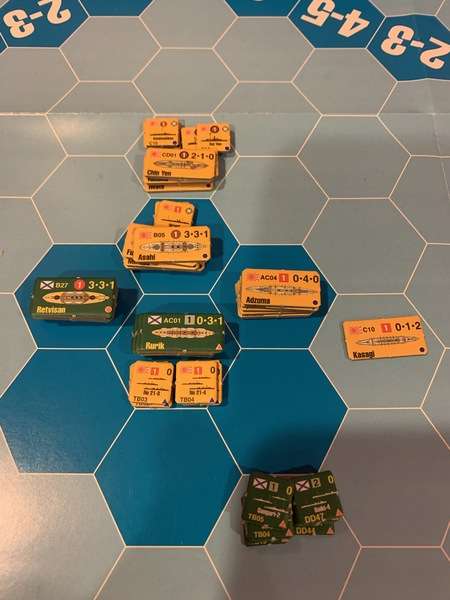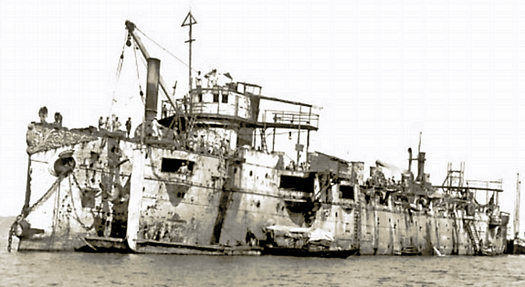My old friend and gaming adversary James (@JamesManto4) recently observed on social media that he’s puzzled by my fascination with extremely granular hex and counter war-games. It puzzles me too. I fell into bad company as a young teen and got introduced to SPI monster games by older, debauched boys is all I can say.
It’s generally true that I divide my time unprofitably and inefficiently between paper hex and counter games and miniature games, and that I probably have more unpunched cardboard than I can get through in whatever years remaining that the good Lord graces me with. I find that operational and strategic level paper games afford a vantage point and level of interest that most miniatures games can’t give me, and when I want a good skirmish or tactical game, out come the minis. Also, both types of games have their own kinds of aesthetic appeal for me.
Are you still reading this? I haven’t even gotten to my main point yet. So here it is. I gave up half way through Russo-Japanese War by Avalanche Press. I just couldn’t pretend that I was enjoying it any longer and having recently turned 58, I am more and more aware that life is short.
Here’s the problem. Even through pre-dreadnoughts, those ungainly, smoke-belching, baroque iron castles of the sea, have their own fascination, and even though the Russo-Japanese naval war has its many fascinations - doomed fleets of a doomed empire, valour, technology at the cusp of change - the game itself is less than fascinating. How could it not be inspiring?
So inspiring!
The problem is that it’s not a very interesting war to game because the quality of the two sides was so varied. The Japanese were a highly drilled, efficient and well-led naval service, and the Russians, well, were not. Any game which wants to model this qualitative asymmetry has to penalize the Russians, so in this game, while you hit on a 6 on a d6 at long range (5 o 6 on a d6 at close), if you’re the Russian player you then have to roll a second confirmation roll (5 or 6 a d6 for each hit) to see if the shell actually hits its target. The Russian confirmation gets slightly easier (4-6 on a d6) after eight rounds of combat, but the handicap against the Czar’s ships is still very severe.
RJW follows Avalanche Press’ Great War at Sea rules system, with a host of variations for the pre-dreadnought era. With two players, the strategic game might be interesting as both sides have to secretly plot their moves, though the general objectives are fairly obvious - in the first phase of the war, the Japanese are guaranteed to show up at Port Arthur in force at a certain time after sailing from their home ports because that’s the main prize. I suppose the Tsushima part might be more interesting for two players, but as a solo game, even with some random directional die rolls to make things fun, the COAs for both sides were fairly obvious. There is some strategic challenge for the Japanese because their total fleet numbers are inferior and so their margin for error is slim, but realistically and historically, they can sink the Russians in two job lots with little fear of disaster.
As a tactical game, RJW isn’t that much fun, to be honest. I decided to sortie the whole Russian fleet from Port Arthur to try and stop the Japanese from landing troops on the Korean peninsula, which meant that they ran into the main Japanese force early on. I then deployed all the ships to the tactical map.

Not so inspiring.
The tactical phases are IGO/UGO start with random determination of initiative, through logically the Japanese, being better sailors, should always have initiative. Ships of different speed classes are then moved in sequences, each speed class getting its own sequence with fastest going first, and between each sequence there is a round of gunfire and then torpedoes if close enough, and the incentive to get close gives the game a sense of Age of Sail. There is a stacking limit of capital ships per hex, and the movement rules are too abstract to allow for subtleties like trying to cross the enemy’s T as in Jutland. You just get in close and then it’s Fire Away Flanagan. Ships have Primary, Secondary, and No armour ratings. Likewise there are three gunfire ratings: Primary, Secondary, and Tertiary. Primary shells penetrate all armour and do extra damage for lightly armoured ships. Secondary shells only penetrate secondary or no armour, and Tertiary shells only damage unarmored ships such as destroyed and torpedo boats. Torpedoes are bow mounted (less effective) and hull mounted (more effective) and are basically close range weapons with a more destructive effect.
Damage is marked off as Hull hits, Gun hits, Torpedo hits, and occasionally critical hits, using ship logs. For a large action like my Port Arthur battle, it becomes a dreary round of checking the firing ship to see if it has lost any gun factors, rolling dice, and then marking off boxes on the target ship as necessary. I remember playing with ship logs as a kid with Avalon Hill’s Wooden Ships and Iron Men and that didn’t seem a bother then, but as I said earlier, life is shorter now. It boils down to lots of die rolling, lots of paper consulting, and lots of marking off boxes. To make a long story short, the Russians were getting the worst of it and their battleships were generally in a bad way, with one sunk. There was some prospect of the Russian torpedo boats getting into the IJN line of battle, but it was a faint hope. Honestly I couldn’t be bothered finishing it.
To be fair, the RJW scenario book as a ton of history and detail, and the full OOBs for both sides are represented in the counter mix, so the game could be a great resource for someone who wanted to play this era using miniature ships. Smaller actions might be fun, particularly if you abandoned history and made both sides equal in capability. It might also be fun to introduce British, German and American ships. However, out of the box, as is, my hopes for RJW sadly foundered and then sank under the waves.

Image: the author’s hopes for a fun game.

Michael, we find much in common! I play both hex and counter and miniatures and prefer boardwargames operation and strategic resolutions. Too bad about Avalanche Press' RJW entry. If the operations of the RJW land war interest you, perhaps look at MMP's "The Tide at Sunrise" as an alternative? A VASSAL module is available as a bonis!
ReplyDeleteHi Jonathan:
DeleteI fondly remember our WW1 vassal game and hope we can try something like that again. I shall look fo hat MMP title.
I have a very old GDW game on the naval RJW which I remember being fun, I should dig it out sometime.
Playing a game over VASSAL again would be very fun. Our foray into WWI was a rewarding experience. I don't know that I could have learned that system without a companion.
DeleteHi Michael -
ReplyDeleteI enjoyed your review - it sounds as though RJW naval is a better resource than game/ simulation. Not only for the details of the vessels, but perhaps for some of the ideas therein. I've recently (last couple of years) been exploring very simple naval rule sets for post 1860 naval warfare, with a more recent view to adding a little 'chrome'. You comment on the Primary/ Secondary/ Tertiary gun and armour types, suggest certain possibilities that might solve some possible problems I have with the sets presently constituted (I'm not sure they are actually problems, yet!).
In my on-going 'Blacklands War', the fleets are based on historical precedents, but I've drawn no distinction between Turkish (Turcowaz) high but inaccurate rates of fire and Greek (Hellenic) slower but accurate. But if I did I'd probably have to use a different shooting mechanic.
I'm wondering if maybe the sort of ultra-simple naval rules - and using models - that I was exploring about a year, eighteen months back might make the Tsushima-type fleet actions a bit brisker and interestinger?
Cheers,
Ion
Hello Ion! Yes the AP title is a great toolkit, and it could be adapted to an Imaginavies campaign where the two sides were more tactically equal. If you like I can scan and send you the general AP Great War at Sea rules, there are lots of good ideas there for a miniaurist to steal!
DeleteGreat post.
ReplyDeleteLike you I prefer tactical games with miniatures and strategic and pol- mil games done with a board.
Shame that the RJW game proved to be a bust. I've had some games using model ship and they proved to be quite entertaining. I was looking at board games to moderate a campaign for them, once I'd got more painted up.
Cheers,
Pete.
Hey Pete:
DeleteI have seen some amazing RJW era ship models, even some at 1/600 scale, and they do occasionally tempt me. I too see a boadgame and wonder if there are miniature campaign uses for it.
Sometimes there is too much historical detail.
ReplyDeletePre-dreadnoughts should be fun but the historical battles (Russia vs Japan, Spain vs US) were pretty unequal.
But P-Ds are just so darn cool.
DeleteIs the RJW just being accurate or are the Russian ships too heavily penalised. It has always struck me that that a good set of rules with cause a player to fear / respect the strength of the other force, if the Japanese player does not fear even potential harm, is that a fair simulation or even an accurate representation of how it was. If it is, I fear the subject as an entertaining game cannot be rescued.
ReplyDeleteHello Norm and thanks for your comment. You make a good point. Even a crap Russian ship could take out a Japanese BB with a critical hit, and exposing the IJN to too much damage before the Russian Baltic Fleet arrives could be risky. In a game with a more tactically interesting system, that would add some spice to be sure. I don't think RJW naval as an historical game is salvageable is my conclusion.
Delete